#do i want to major in mesoamerican history or something. i don’t think that’s a major they would give me
Text
would it be ridiculous to major in classics
#here at lincoln it would probably be a little ridiculous since the official program title is classics and classical religions#and like. i find religion vaguely interesting as a concept but i don’t want to major in like. jesus and his dad god#i’m aware that since it’s classics it would probably be more like greek and roman gods but that’s still just really not my interests?#it’s just that i keep meeting people and saying yeah i’m planning on being a history major and they’re like oh what era of history??#what’s your favorite historical period you must have one??#and i’m just like…. idk dude i’m hoping to spread information on it all not pick a favorite time and only do that?#my focus is more on the distribution of information than which information it is. history is just a good starting point#i do kind of wonder about majoring in something like comparative literature but i don’t know strongly enough if i really want to do library#like comparative literature is a cool major that i’m interested in but it wouldn’t lead very well into museum stuff#and i’m more interested in museums and non-library archives. so it would be kinda dumb to switch to an english major to start out#anyway this is friggin college talk again and i’m really sorry#i’m still gonna tag it and everything and i’m still stressed about it in general but it is entirely on my mind right now#like if you look at my brain 2% is will woods new album 4% is what i should wear today and the other 94% of it is dedicated to college stuff#wait also i’m realizing i never really explained why classics is at all relevant right now i got half way there and then distracted#i think i’ve landed on not wanting to do classics though. but basically i started saying to what era i like i say it’s just art and culture#like what kind of history do i like? oh all of it as long as there’s people there being people#and according to. everyone i’ve talked to. that means ancient rome and nowhere else. so#yeah honestly why would i do that. like. other people friggin exist the world really doesn’t have to be centered around europe#like. latin is cool and everything. but that’s not the rare language i want to be learning can i learn like. nahuatl? purepecha?#do i want to major in mesoamerican history or something. i don’t think that’s a major they would give me#but definitely what i’m getting here is that ancient greece and ancient europe in general is not my interest#like. don’t get me wrong i find medieval history really cool and like. the renaissance and lots of old european painters and composers#but at the end of the day those are things that i think are pretty. not things i want to devote my life to#i think indigenous history might be a good thing to look into. i doubt they have that at this school#it would probably still be in my best interests to get something very broad like history. but idk#anyway i’ve been talking long enough i can shut up now. just. yeah#me. my post. mine.#college talk
10 notes
·
View notes
Text
Created by Elizabeth Ito, the animated series City of Ghosts explores the history of different neighborhoods in Los Angeles through friendly ghosts that make the past of this metropolis real. Our guides into these adventures, created in documentary style, are a diverse group of children, the Ghost Club, who navigate each encounter with curiosity and compassion.
For episode six, focused on Koreatown, the creators recruited professor Felipe H. Lopez, a Zapotec scholar to help them portray the Oaxacan community of L.A. With Ito and producer Joanne Shen’s support, Lopez brought authenticity to the depiction of certain visual elements, such as the grecas de Mitla, geometrical designs specific to the Indigenous people of Oaxaca. More importantly, he voices an animated version of himself, as well as Chepe, a lovable alebrije ghost at the center of the story. Lopez’s dialogue is both in English and Zapotec.
A native of the small Oaxacan community of San Lucas Quiaviní, where the vast majority of the population speaks Zapotec, Lopez has become a binational bastion in the preservation of this Indigenous language and the culture it gives voice to. He came to the United States when he was 16 years old speaking mostly Zapotec. He learned English first and then he worked on improving his Spanish while at Santa Monica Community College.
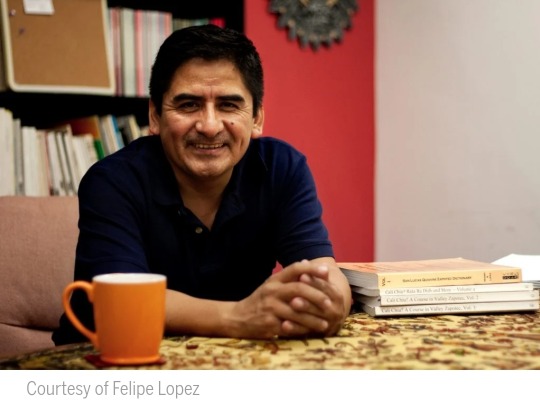
In 1992, Lopez got accepted into University of California, Los Angeles (UCLA) in the Latin American studies program; he has restlessly devoted himself to preserving the identity of the Zapotec diaspora, which has been present in the United States since the days of the Bracero program. Lopez first found support in linguist Pamela Monroe with whom he created the first trilingual Zapotec dictionary, which was published in 1999 via the Chicano studies department at UCLA. Today he is a postdoctoral scholar at Haverford College.
Below, he expands on his life’s work and the significance of the positive mainstream representation of Indigenous peoples.
What was the impulse or situation that made you realize you wanted to dedicate your professional life to preserve the Zapotec language and culture?
There’s always this relationship between economic gains with language. I saw how a lot of families in the Oaxacan community were raising their kids. Even if they didn’t speak Spanish fluently, they wanted to teach their kids Spanish rather than Zapotec. In a sense, they didn’t see a lot of usefulness in teaching their kids Zapotec. Interestingly, some of them actually were teaching their children the little English they knew. They even skipped teaching them Spanish. The parents would speak with each other in Zapotec but then would talk to the kids in English.
Being a college student back then and thinking about those things made me realize that the language was being lost and being substituted by either Spanish or English. At that moment I thought, ‘Maybe my language is going to be lost. I’ve got to do something about it. Even if it is just to leave a record. I want it to at least be known that we spoke this language at one time.’ That’s what really drove me to seek out somebody to help me because I’m not a linguist. Ever since then, we’ve been creating a lot of open source materials in Zapotec for people to use. We now have dictionaries. We’ve really used the technology in order to make our language, our culture, and how we are visible. City of Ghosts is another component that continues the work we started in 1992.
One of the interesting things about Indigenous languages is that sometimes they are not seen as real languages. You have this battle against the established ideology that Indigenous languages are not really languages. It’s almost like being salmon going against the current, if you’re trying to preserve your language because there are very few spaces for you to use your language and it’s not being taught in public schools in Mexico. But I was fortunate to be able to teach one of the very first courses in Zapotec. In 2005, UCSD [University of California, San Diego] asked me to teach a course in Zapotec. We needed to create all the materials from scratch because unlike Spanish or English or French, which are the dominant languages, you have tons of materials. If you want to teach Spanish you can go to the library and you have tons of materials to teach. But for us as Indigenous teachers we really need to create materials.
Language is deeply connected to how a culture sees the world. In that regard, why do you think it’s necessary to protect and teach Zapotec and other Indigenous languages in Mexico?
A lot of our Indigenous knowledge is embedded in the language. For example, when I think about how we’re being taught math in school from a Western point of view, we have the decimal system of counting: 10, 20, so on. But in Zapotec we have a different counting system, which is a base 20. We do 20, 40, and 80. Sadly, in Mexico something people say, ‘Why do you want to preserve the language? It’s not even a language. It’s a dialect.’
Fortunately, last year, I think if I’m not mistaken, Mexico changed the constitution to recognize more than 68 languages spoken in Mexico as national languages. There has been a long struggle. I’ve been doing work both in the U.S. and Mexico. Currently I’m teaching a free course on Zapotec in one of the universities in Mexico, because I want to contribute. Indigenous languages are important because they represent our history. They represent our identity and the ways in which we see our surroundings. There are even words in Zapotec that I can’t even translate into Spanish because there are no concepts that are equivalent. They need to be explained.
With the constitutional changes that you mention and someone like actress Yalitza Aparicio inspiring conversations about racism in Mexico and across Latin America, do you believe we are on the brink of a deeper appreciation of Indigenous culture and language?
It’s interesting that you mentioned Yalitza because when she first came out people attacked her. They would say, ‘She’s an Indian. She doesn’t deserve to be there.’ It is the sentiment that has endured in Mexico and Latin America. It’s a colonial mentality. If you look at the soap operas and Mexican TV shows just about every single actor or actress is white. There has been a push historically for Mexico to aspire, to be white. We, as Indigenous people, have been perceived to be a problem for modernity. They feel like, ‘How can Indigenous people be modern?’
We tend to be very fluid and move into different cultures, into different eras. I can speak my language in my pueblo, but at the same time I can use the Internet and I can speak English.Being Indigenous is never a detriment.In Mexico, the dominant culture, the politicians and the [non-Indigneous] intellectuals, see us as something less than Mexican. They speak about Mexicans versus Indigenous people. I’ve always questioned that because they like to talk about Mexico’s Indigenous roots, yet ostracize and put us on the margin. When they speak about Indigenous communities, they tend to think of us in a museum because once you put us in a museum it means that we no longer exist. There is this contradiction in terms of where we are, where we fit in Mexican society. That’s why we’re pushing so hard to make ourselves visible.
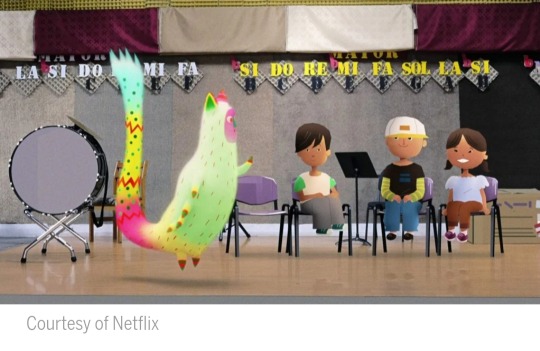
Specifically speaking about Zapotec people, and other immigrants from Indigenous communities, in the United States, what are the major obstacles in resettling?
Indigenous immigrants go through two steps of assimilation, because a lot of us who move into the States, we bring our indigenous language and culture. But the dominant culture that exists in LA is a Mexican or Mexican American culture. It’s a mestizo culture and there’s Spanish. So we as Indigenous people first need to assimilate into that culture and then assimilate into the mainstream culture. We need to speak English, but we also need to speak Spanish. There are two steps of assimilation for us to even try to situate ourselves in mainstream American society.
Tell me about your experience working on such a unique show as City of Ghosts, which really digs deep into the cultural fabric of Los Angeles. What convinced you that this could be positive for Indigenous communities?
One of the things that I asked Joanne [Shen] was, ‘How much say do I have?’ Because I didn’t want to be there if they already had an idea and they just want me to emulate something. So she said, “No, we want to sit down with you and talk about what are some of the important aspects of Zapotec society and what is it that really impacts you guys? How do you see the world?” That was one of the most important things for me in order to agree to do the project.
We had several meetings in terms where they asked me questions. Once I looked at the whole script, not just mine but also those for the alebrije ghost Chepe and Lena who is voiced by Gala Porras-Kim, I made some changes according to how I felt it represented Zapotec culture. For example, tying the idea of the ghost with the idea of the nahual orthe alter ego in Zapotec and Mesoamerican culture, as well as the use of alebrijes and the colors, which properly represented Zapotec culture on the screen.
They were very sensitive and they wanted to get it right. I really commend them for that, because I’ve worked in projects where they don’t really care. They have an agenda. But for this project they were so attuned with me.I think that’s what makes City of Ghosts such an important program for kids and just for the public at large to understand who the Zapotec are, because when we think about the Mexican community we assume that everybody speaks Spanish. This program, and specifically episode six, will help people to at least begin to rethink Mexican society and that not all Mexicans speak Spanish. Not all of them are mestizo, but rather that we are a multilingual and multicultural society, and we are bringing that to the States. I hope it makes people at least curious.

One aspect prominently mentioned in your episode is how certain Oaxacan communities use a whistling language. Why was this a significant element?
To be honest with you, I have no idea where it came from, but as far back as I remember when I was a kid we would just whistle to communicate basic phrases to each other. Also when we go to work on the field and you see somebody far away, you whistle at that person just to get some information like, ‘How are you doing? What’s going on?’ Since, we didn’t have any phones back home then, we whistled to communicate, but it’s not entirely just Zapotec communities. There are other Indigenous communities in Oaxaca and Mesoamerica that use whistling as a means of communication. So when I was asked to be part of the show, I did a lot of whistling in the episode just demonstrating how we communicate and that we don’t need words. Whistling is another expression of language.
When you think about Angelenos you think about Mexicans or mestizos at the pueblo of Los Angeles. But we rarely talk about the Indigenous people in LA. By having the Zapotec people in this sho2, we begin to have this conversation go beyond thinking about this land only having Latinos, African Americans, and whites. There are these hidden multicultural societies here that have been fighting and resisting against all these forces.
One thing that is so interesting to me is that when we are on the margins, we tend to fight and resist at the margin to maintain our language and culture. So then by bringing us into the light and being visible, even by asking, ‘Where do you guys come from?’ We can say, ‘Well, we’ve been here all along. You just haven’t seen us.’ With these particular episodes on the Zapotec, all of a sudden some people might learn something. I’ve seen on Twitter the young Indigenous people express they feel so proud of the fact that Indigenous people are represented in this show. There’s something unique about this show, because it really brings some of the historical aspects of the composition of LA, specifically of the Pico-Union area.
The most important thing people should take out of those two episodes that talk about Indigenous communities, it’s the very first time that we see Indigenous communities well represented and not objectified, but just as human and what they do in everyday life. And also how we bring our traditions and cultures to some of the megacities in the world, coming from small communities, such as mine where we have about 1700 people, yet we are being represented in such an incredible episode.
City of Ghosts is streaming on Netflix.
1 note
·
View note
Text
Alexandra the Great
Alright, I’ve finished work, had a nice nap, drank some more coffee, and I am READY to rumble.
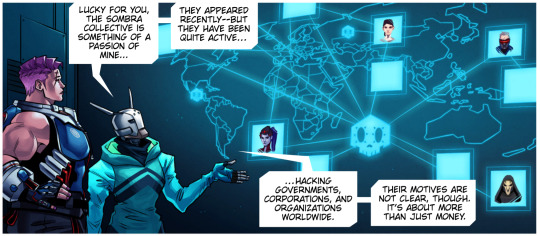
The new comic gave us a lot of great details to work with - some of it takes a little digging, some of it is speculation, but it feels like, after a year and half of slow, steady story and world-building, constructing the “details” is finally paying off for Blizzards. This comic had so much to work with, and you can tell that the writers and the artist were so dedicated to making it feel like the most in-universe, grounded comic yet.
To start off with, I’m going to present a few things.
First, you should read these, if you haven’t already:
http://segadores-y-soldados.tumblr.com/post/164852538245/overwatch-companies-and-corporations
http://segadores-y-soldados.tumblr.com/post/164417776210/devil-in-the-details
http://segadores-y-soldados.tumblr.com/post/163200042035/death-becomes-you
You should also have this:
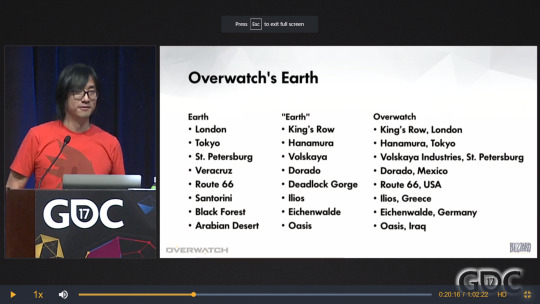
(I’ve seen a lot of people get confused on things like Volskaya’s location vs the “Krasnoyarsk Front, Russia,” where Dorado is, etc. These are straight from Michael Chu himself. The columns go: [Real world locations] > [the versions that Blizzard wanted to make for the game] > [the end “combination”])
And finally, a rough timeline of where “Searching” fits in with the rest of the current events in the Overwatch plot:
[Infiltration] > [“Searching” begins] > [“Masquerade” comic occurs (approximately late February, around Carnival in Venice)] > [“Searching” continues] > [Doomfist attacks Numbani] > [Efi makes Orisa] > [Zarya arrives in Numbani]
This essay will be operating on the premise that Sombra and Reaper are working together in some fashion, specifically that they are working on either 1) uncovering the conspiracy that Talon is a part of together and/or 2) to bring down Talon together and/or to take over Talon together.
Let’s begin.
Corruption in Corporations

It was fantastic to see that the very first thing Zarya did was make an effort to seek out major corporations that could have been affected by Sombra. Recall that at this point, most of the world knows that Sombra targeted LumériCo in an effort to reveal corruption by Portero and his corporation to the world.
The Sombra ARG also highlighted that Portero had direct connections with individuals in two other major corporations - Sanjay Korpal of Vishkar, and Katya Volskaya of Volskaya. We don’t know the exact nature of these connections, but in “Companies and Corporations,” I write that the larger thematic issue we are being shown through these three companies in particular is that corruption runs in circle - a “network” of mismanagement, power, and control that results in profits for those at the top.
If anything, this comic reaffirms that idea, as Zarya works through her own list of “leads,” starting with a company that has quietly flown under the fandom “radar” - Lucheng Interstellar.
With the narration by Winston in the video, we have a better understanding of the unethical, probably inhumane treatment of the gorilla troop that lived in the moon colony. The gorillas were subject to injections that gave them the intelligence of at least humans, and they were seemingly subject to some harsh rules. Emails in the “New Details Emerge About Possible Fate Of Horizon Lunar Colony” article (https://playoverwatch.com/en-us/blog/20812209) show that the gorillas (or “specimens”) were often put in “in their rooms” when they acted up. At the very least, one “speciment” (Hammond) was put in a cage.
Lucheng is suspicious for their probably unethical treatment of animal test subjects, the “genetic manipulation” of them, and their radio silence on the issue for what is apparently several years.
Lucheng has yet to play a “huge” role in the current Overwatch plot, but they do feature into the background of Winston, whose narration for the Horizon Lunar Colony map details some unethical and likely abusive experiments against the gorilla troop living on the moon. Lucheng’s central control room is also one of the KOTH maps for Lijiang Tower, though no real explanation is given as to why people are fighting over the room.
Does Katya have connections to Lucheng? Hard to say at this point, but rather, the detail of Zarya thinking that Sombra might have an interest in the company is a telling one, one that the comic dances around until the very end:
Though she does not fully realize it, Zarya is actually more suspicious of the looming power figures in the world than her “enemies” - Omnics...and Sombra herself.
Before I get more into that, I’d like to mention that I was thrilled to see a certain “corruption CEO” make an appearance:

I’ve said for quite some time now that the motifs behind Portero and LumériCo are representative of a really cool, really interesting concept grounded in Mesoamerican mythology, specifically Aztec and Mayan stories and world concepts. Seeing this panel just confirms that the idea is still present.
Dorado itself was rather blindly (hah) designed by the Overwatch team who, in their haste to make a “bright, colorful village map,” drew references from an Italian city by the sea (gj guys, way to double-check your sources). But the LumériCo power plant was almost certainly designed based on the Laguna Verde Nuclear Power Plant, which exists in almost the exact same location as Dorado’s maps (note that the in-game map within the LumériCo appears to be incorrect, as the Uprising map confirms that Dorado is supposed to be further south on the Gulf of Mexico). More than anything else, the LumériCo power plants are designed to evoke the pyramids of Aztec and Mayan design. These were massive stone builds of ritual, political, and social power that were meant to mimic the mountains that gods such as the Feathered Serpent, Tlaloc/Chaac, and Huitzilopochtli were believed to live on. They were also meant to be displays of power and regality by various kings, queens, and rulers.
So like the Temple of Anubis, the LumériCo power plant is a remixing of “real world mythologies” with the dev team’s “vision of the future,” a vision where humanity celebrates its diversity and the beauty of its multitude of ideas and histories with a “futuristic twist.”
But what it also implies is that Portero - the CEO of LumériCo - is imposing himself as a psuedo-ruler in Mexico.
From here: http://segadores-y-soldados.tumblr.com/post/159665523340/overwatch-apocalypse-now
The entire Sombra ARG was about Sombra attempting to “dethrone” Portero. This isn’t even subtext or close reading - this is literally how Sombra herself describes her actions:
“The King Guillermo Portero of LumériCo invites cordially, his loyal servants, to participate in his crowning event and to celebrate his infinite greed and treason toward the people of México. We gave coordinated the publication of info that demonstrates that Portero is a viper, that have for a long time ripoff the riches of our country for his own wealth. He has corrupted our government, turned our sisters and brothers into beggars, and he won’t stop until controlling the whole country under his dominance. But we, Los Muertos, won’t tolerate the celebration of his reign of corruption. We’ll demonstrate to our new conquistadores (conquerors) who will take the reins of the future of our country! On November 1st, we’ll dethrone the King Viper and we’ll celebrate the recovery of our home.”
Zarya references this fact as well, on the next page of her comic:
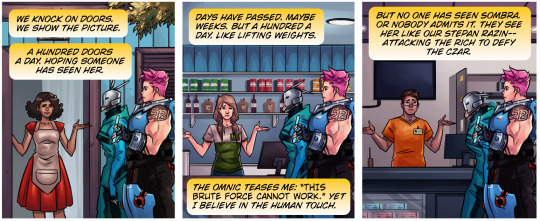
Here, she talks about Stepan Razin, who led a popular uprising against the Tzardom and nobility of Russia in the 1600′s. The implication of these three panels is that everyone in Dorado (save LumériCo) knows who Sombra is, but they aren’t telling Zarya and Lynx because they support Sombra’s actions.
This is important
because Zarya is the exact same type of “popular folk hero” to the people of Russia as Sombra is to the people of Dorado.
From Zarya’s hero profile:
Aleksandra Zaryanova is one of the world's strongest women, a celebrated athlete who sacrificed personal glory to protect her family, friends, and country in a time of war.
Now she serves—a symbol to some, a stalwart fellow soldier to others. But for Aleksandra, it is a chance to use her great strength to protect the ones she loves.
Though subtle, we start to see some of the doubt being cast over Zarya about her actions, the things Katya told her, her interactions with Omnics (and Lynx specifically), and this seemingly wild goose chase she’s been put on.
Is Zarya’s power helping the people...or is it helping something more sinister?
Soldier or Hero?
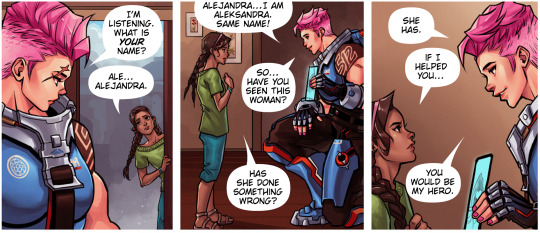
I think I actually gave an audible gasp at this point.
This is where we can see the details of Blizzard’s slow, almost painfully deliberate world-building process start coming together.
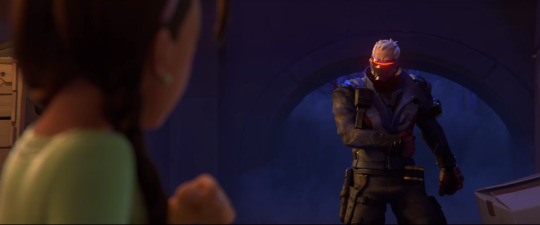
These sets of panels are a great reference to the “Hero” animated short, and show us how everything in the Overwatch story - every line, every action, every idea - has a ripple effect. It’s been about a year and a half since the “Hero” animation was released, and, in theory, about approximately the same amount of time has occurred “in-universe” in the main Overwatch plot (“Recall”/“Alive,” “Hero,” and “Dragons” all occur approximately at the same time as the game’s official release, with “Recall” leading right into the “Are you with us?” message Winston sends to “agents” aka players).
At the end of the “Hero” animation, we see that Soldier: 76′s actions of fighting Los Muertos members and saving Alejandra has resulted in her being inspired to be braver and more heroic.
Alejandra: You’re one of those heroes...aren’t you?
Soldier: 76: ...Not anymore.
Alejandra: ...I think you are.
And finally
FINALLY
after all this time
we see some of that pay off.
In “Searching,” one of the Overwatch main cast finally comes in contact with Alejandra, and what do you know -
It happens to be the woman with the same name.
“Aleksandra” and “Alejandra” are both linguistic derivatives of the feminine form of “Alexander” - “Alexandra” in English. All of these names generally stem from the most famous “Alexander,” Alexander the Great, the often romanticized Macedonian general and king who founded one of the greatest empires in antiquity. Names deriving from Alexander are meant to inspire thoughts of heroism, bravery, courage, and -
Oh yeah -
The name Alexander is derived from the Greek Ἀλέξανδρος (Aléxandros), meaning "Defender of the people" or "Defending men" and also, "Protector of men", a compound of the verb ἀλέξειν alexein, "to ward off, to avert, to defend"and the noun ἀνήρ anēr, "man" (GEN ἀνδρός andros).
So, inherent in her very name, we see Zarya’s dilemma arise again:
Who is she defending? The people? Or those already in power? Who is she “a friend” to?
These panels between Aleksandra and Alejandra are great for highlighting a major turn-around moment, for both characters: Aleksandra shows her charm, her kindness, and her patience, getting down on the same level as Alejandra, telling the girl that if she helps her, Alejandra “would be her hero.”
And as we know, being heroic is what Alejandra wants and believes in more than anything else.
We can even see some of the hesitation here: Alejandra, who presumably knows Sombra as all the other people of Dorado do (by her civilian name), is reluctant to give away Sombra’s information (Sombra also has a line on the Dorado map about “stopping by the bakery,” implying that she knows Alejandra and her mother or at least sees them on a regular basis). But Alejandra makes the decision to “be a hero” and explain where Zarya and Lynx can find Sombra, especially because Sombra has “done something wrong.”
Connecting the Dots
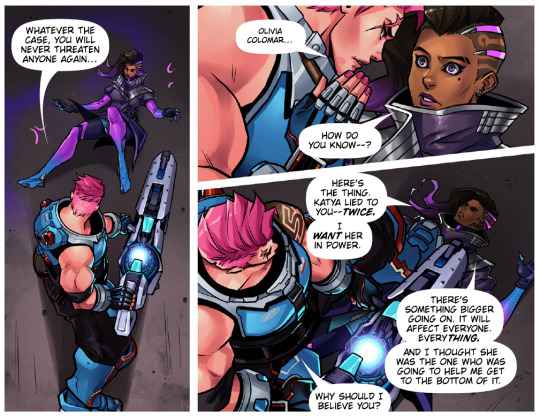
“There’s something bigger going on. It will affect everyone. Everything.”
“Why should I believe you?”
“Hahahaha, listen, mi amiga. Between me and Katya, one of us hasn’t lied to you.”
This is, by far, the most cryptic part of the comic. Why does Sombra want Katya to have considerable social and political power in Russia? Hell, even real military power, when you consider her mechs?
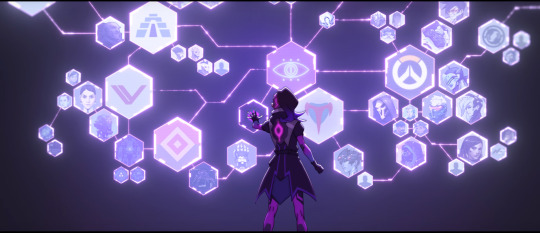
Since all the Overwatch characters are unreliable narrators, you can’t always take their word at face value. We do know that Sombra believes Katya should stay in power - we saw this in “Infiltration.” So at the very least, she believes Katya is of more use alive rather than dead.
What we need to look to next is other clues that we have. And the biggest one is Sombra’s version of her interconnectivity/relationships web.
So we also know that there’s a conspiracy - probably the “something bigger” Sombra tells Zarya - represented by The Eye symbol at the center of Sombra’s web. And the “corrupt” corporations like Volskaya and LumériCo are connected to it, along with “a group” in Numbani, Talon, and even Overwatch.
It’s difficult to say at the moment if The Eye represents the Talon council alone, or something “much bigger,” which it is definitely looking like.
Remember what caused the original Crisis?
A corporation that got caught up in fraud and corruption.
Doomfist’s goal is to bring about a global conflict that will drive both humanity and Omnics to be “stronger.” His ideology is a twisted form of Social Darwinism, but if you’ve read some of my other stuff, you’ll know that he’s not “wrong” in the sense of history. Forcing conflicts helps a very select group of people:
The Military-Industrial Complex.
This is a term to describe the people, groups, corporations, technologies, and industries that “profit” off of war. Typically, these are weapons manufacturers or defense companies that produce the supplies needed in wartime endeavors...
(From here: http://segadores-y-soldados.tumblr.com/post/164852538245/overwatch-companies-and-corporations)
It is tantalizing to speculate beyond this, but at the moment, it’s not clear who or what exactly is involved in this. Rather, I would say that Doomfist’s “revitalized” Talon’s goal is to set out to create a conspiracy “network” that enmeshes many of the larger corporations and organizations into a unified “conflict” organization that can create wars whenever they need to.
And before people jump at this, remember.
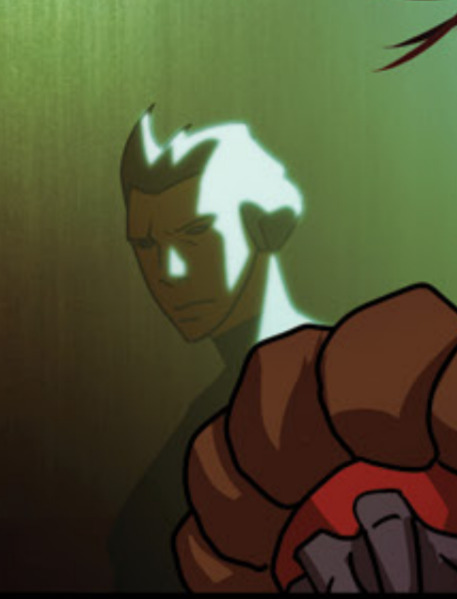
Doomfist already has one “corrupt corporate” member on his council.
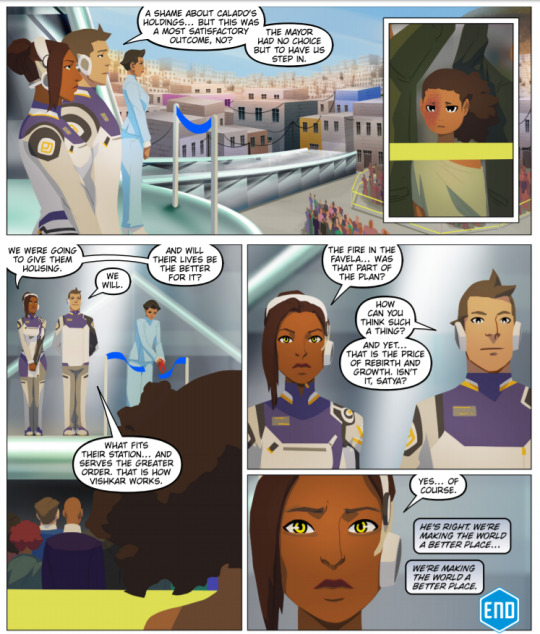
Sanjay Korpal...
Who has connections to Guillermo Portero...
Mr. Portero,
I have conveyed the contents of our latest discussion with the executive directors and they are all in agreement in principle on the framework for a deal. Of course there will be a lot of discussion and communication in the coming days, but I am optimistic that we can reach a mutually beneficial understanding.
I understand your concerns over the recent press about our Rio de Janeiro development, however I can assure you that this is just a blip on the radar and that we are taking care of it. And of course, we are more than happy to keep our negotiations private until such time that you feel comfortable in discussing them with the public. And of course, we are more than happy to assist with smoothing over any conflicts that might come up in opposition of our proposals.
Sincerely, Sanjay
Who has connections to Katya Volskaya.
The Sanjay link is a big deal. I’m not going to say that Guillermo and Katya are “part” of the Talon council until we have further proof of their direct involvement. But at the moment, they look like they might be...beneficiaries of some sort of overarching protection, possibly “enforced” by Talon.
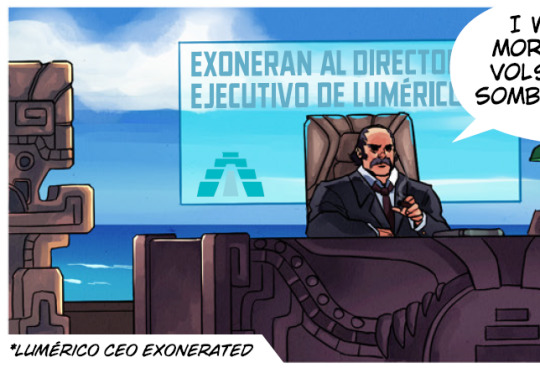
I’ve seen almost no one comment on this, but Portero being exonerated “of his crimes” and then reinstated as the CEO of LumériCo is a major detail -
Because, in theory, it “undoes” all of the work of Sombra’s email leaks.
Sure, yes, it could mean that Portero never actually did anything wrong. But no one believes that at this point. Even if Sombra is an unreliable narrator and her motivations are not “just” or “noble,” we still have his emails, his shaky connections to Volskaya, the weird power plants, the psuedo-Mesoamerican-styled “pyramids of power.” Even Soldier: 76 is suspicious of him.
And of course, we have his connection to Sanjay, and therefore to a member sitting directly on the Talon Council.
And this is another great detail of the Zarya comic:

Almost everyone “in power” is corrupt in some way.
Zarya should not be able to go to the police of another country, ask for highly sensitive details on a black market hacker, and get vague promises of being shared results. (And in the background, Omnics are being “herded” somewhere.)
Absolute power corrupts absolutely. And corruption bleeds down to everyone.
This is a thematic issue that we will see repeat itself time and time again - that corrupt companies and corporations are undermining global stability and peace, whether directly or indirectly.
Corruption and the misuse of power are not “structural, hierarchical ladders” in the world of Overwatch.
Corruption and the misuse of power are circular, connected, linked together -
into a spider’s web.
What is also great about the Zarya comic is that we get a new web to double-check Sombra’s against.

We have to keep in mind that Lynx’s web is a little bit different - Lynx is an outsider “looking in” at the pattern of Sombra’s attacks and her connections. Lynx seemingly has “no connections” to the larger story, but they do come “recommended” by Katya.
But Lynx’s web does give us some insight because it offers some minute locational data that Sombra’s web does not.

Yellow simply represents a direct “line” to Sombra, whatever that line represents. Red represents secondary lines of connection (again, whatever that means specifically). The blank box connected to Soldier: 76 is likely Ana, who Sombra is already aware exists. Lynx’s web might not know who Ana is, but might call her by her bounty hunter name, “The Shrike.” One of the other blank boxes with a direct link to Sombra might be Doomfist.
Remember, this could be Lynx’s “speculation.” It’s difficult to say.
In my opinion, the most interesting part here isn’t actually the Soldier: 76 - Sombra link, but the weird triangle connected in the top.
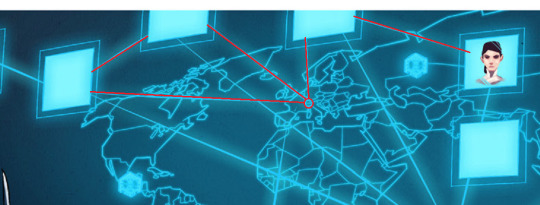
Katya has direct ties to one of these individuals (possibly Portero), who - along with two others - have connections to a circle around...
Switzerland?
Now, before people jump up about Chateau Guillard and Annecy -
Widowmaker’s line actually terminates at a specific location in the web.
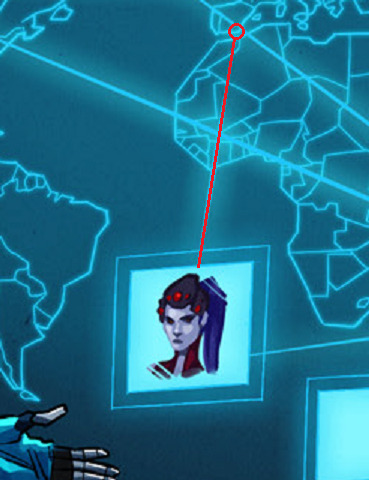
Yup.
That’s probably Gibraltar.
Which is weird, because we have no reason to believe she’s been there. In fact, Reaper has been to Gibraltar “recently,” when he went to steal the Overwatch agent list from Athena and “inadvertently” caused Winston to initiate Recall.
So believe me, I’m just as confused by this as you are. I don’t know what it means. I don’t know if this is an error and Reaper and Widowmaker’s portraits in Lynx’s web were misplaced. I don’t know if it means something more. For now, I’m taking Lynx’s web with a grain of salt.
What we do know is that there are three individuals or groups that Sombra has “hacked” or made some sort of connection with who have ties or their own connections to something or someone in Switzerland.
Which, I mean.
These maps of “active Overwatch investigations/areas of interest” from the “Uprising” comic provide additional support for the circle on Lynx’s web being something related to the Swiss Base Watchpoint.

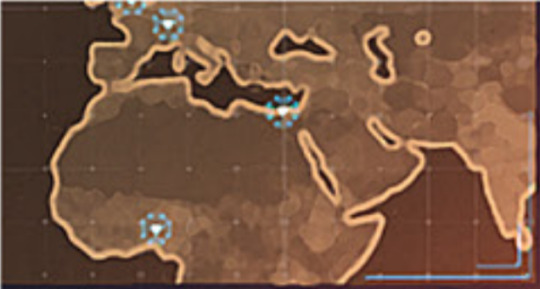
Could Blizzard tease us any harder?
Even if she herself isn’t looking at people with direct connections to the fall of Overwatch, Sombra is actively investigating people with ties to Switzerland. Which is very interesting when you consider that two of the people who have portraits and “direct lines” to Sombra

Are also actively investigating people with ties to Switzerland - specifically, the fall of the Swiss Base. Reaper’s investigation of the matter is more hypothesized/speculated (again, this essay assumes that the hypothesis that Reaper and Sombra are working together “in some way” is correct), but Soldier has actually stated multiple times that he’s trying to figure out “who caused the fall of Overwatch.”
Now -
Lynx doesn’t know any of this.
Hypothetically, this makes Lynx an unbiased source. Again, take all that with some skepticism - Lynx was recommended by Katya, and they were also hacked by Sombra while Zarya and Lynx were still in Numbani (we don’t know when exactly). So “biased” vs “unbiased” is very loose here. But I do think we can at least use Lynx’s web to explore some theories.
Lynx might suspect that Soldier: 76 is Jack Morrison - hell, the entire world of Overwatch “suspects” it at this point (https://playoverwatch.com/en-us/blog/19809396/), but Lynx has no idea who Reaper is, and what his connections to Sombra are, just that the two work together “for Talon.”
But we the audience know that isn’t entirely true.
Michael Chu has stated that the only people who know Gabriel Reyes is Reaper are Soldier: 76/Jack Morrison, “The Shrike”/Ana Amari -
And Sombra.
Therefore, Sombra’s in-game interactions with Reaper can be considered “canon.”
Sombra: What's the plan today, Gabe? You don't mind if I call you Gabe, do you?
Reaper: Stick to the mission.
Reaper: Try to stick to the plan, Sombra.
Sombra: Look, someone has to be ready when all your careful planning doesn't pan out.
And that includes this fun little tidbit on Oasis:
Sombra: So what are we doing here, boss?
Reaper: I need to pay a visit to a friend.
If you’ve read my other essays, you know that I generally support the theory that Reaper is in Oasis to visit Mercy, or someone connected to her. Mercy’s last known location as of Recall was somewhere in the Arabian Peninsula, “close” to Oasis’ location.

Based on the “Reaper sightings” map on Necropolis, Soldier: 76 and Ana are also aware that Reaper has been to Oasis (these locations are: Los Angeles in “Reflections,” Gibraltar in “Recall,” Numbani in the Museum Heist trailer, St. Petersburg in “Infiltration,” and Oasis for some reason).
I would argue that, even if they have their differences, there is a tentative trust between Reaper and Sombra - he trusts her enough to bring her along on his “personal mission” in Oasis, and we know they “have a plan” together.
I will posit the hypothesis that Sombra is feeding information about Reaper to Soldier: 76 and Ana, though I don’t know how much I buy it myself. Either way, the breadcrumbs are there, if you wish to make that connection. I just find them a little too thin, even for my own speculating, conspiracy-lovin’ ass.
No matter what, I will agree that Sombra is at the center of a movement to try and “bring down” a major, global-politics-dominating conspiracy, which may have had a hand in destroying Overwatch.
Which Katya has “some sort of connection to.”
This is alluded to at the very end of Zarya’s comic, in which Zarya has - much like Reaper - decided to tentatively trust Sombra over Katya. It is not known if Sombra somehow gave Zarya more information, or promised to, but at the very least, Zarya seems to have pieced together that “something bigger” is happening with Katya - “something bigger” than just using Omnic technology in her mechs.
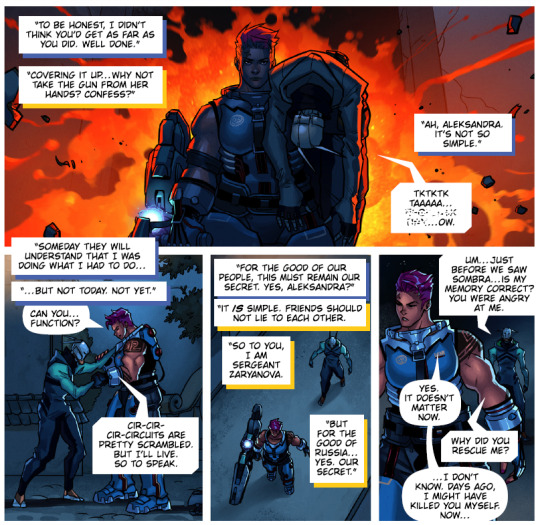
The dialogue here gets really awkward with the layout, so I’ll try to give a direct transcription, and then my interpretation of it.
Direct:
Katya: To be honest, I didn’t think you’d get as far as you did. Well done.
Zarya: Covering it up...Why not take the gun from her hands? Confess
Katya: Ah, Aleksandra, it is not so simple. Someday they will understand that I was doing what I had to do...But not today. Not yet. For the good of our people, this must remain our secret. Yes, Aleksandra?
Zarya: It is simple. Friends should not lie to each other. So to you, I am Sergeant Zaryanova. But for the good of Russia...Yes. Our secret.
There’s a ton to unpack here. I’m going to give my interpretation/rewrite of the lines first.
Interpretation:
Katya: To be honest, I didn’t think you’d get as far as you did. Well done.
Zarya: Hiding the truth...Why don’t you simply admit to the public where you get your tech from? Take the “gun” from Sombra’s hands?
Katya: Ah, Aleksandra, it is not so simple. They won’t understand that I was doing what I had to do. Maybe someday, but not today. For the good of our people, this must remain our secret. Yes, Aleksandra?
Zarya: It is simple. Friends should not lie to each other. So to you, I am Sergeant Zaryanova. But for the good of Russia...Yes. Our secret.
What’s happening is that there’s a very interesting implication of “something more” lurking behind Katya’s words - that if she admitted she got technology from Omnics to the people of Russia, “something bigger” might come out.
(I also wanna say that I love the return to the lines on the first page here - the reference to “friends not lying to each other,” “I am Sergeant Zaryanova” vs “Aleksandra,” “it is (not) simple,” etc. Even if the layout of the dialogue is awful, the actual writing is wonderful.)
What is also implied is that, very subtly, Katya and Zarya have settled on different meanings of “for the good of Russia.”
While Zarya is willing to keep the secret about the Volskaya mechs - and possibly “something bigger” - in order to maintain some sort of peace, she recognizes that her own goals are for the people, whereas Katya’s goals are for herself. We have come back to Zarya’s biggest dilemma:
Who is she defending? The people? Or those already in power? Who is she “a friend” to?
I don’t think it’s a coincidence that Michael Chu has danced around the word “friend” with regards to Sombra and her “allies” within Talon. Specifically, Michael Chu has said that Sombra considers Reaper and Widowmaker “friends,” though to Sombra, “friends” and “enemies” are not so different.
It seems, then, at that the end of this comic, Zarya has come to a similar sort of conclusion.
Omnics can be good allies.

Her “heroes” can be corrupt.

Her “enemies” can tell the truth.

And her “war” -
Her fight -
Can be for “something bigger” than her country.

What does it take to make a hero?
Strength?
Courage?
Power?
Perhaps it is the ability to do what is right.
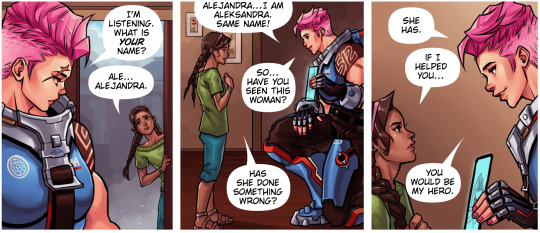
#Zarya#aleksandra zaryanova#overwatch lore#overwatch theories#searching comic#my essays#katya volskaya#alejandra#sombra#reaper#soldier 76#long post
402 notes
·
View notes
Text
I made this post basically because @andasideofpanache told me to.
So there’s a bit of a kerfuffle going around because the makers of Game of Thrones announced that they want to do an alternate history show about what life would be like if the Confederacy had won the American Civil War. And I don’t know how I feel about it, exactly, other than I think it’s...kind of boring? As far as alternate histories go, it’s pretty standard. “If the Confederacy won the American Civil War” and “If the Nazis won World War II” are the two alternate histories I see all too often and that’s horrible because the answer is that life would suck.
I think it’d be much better if you took some other point in history and took something that was pretty much neutral and said what if it’d gone the other way? So for the viewing pleasure of the followers of this blog:
A BUNCH OF ALTERNATE HISTORY IDEAS THAT ARE MORE INTERESTING:
-What if Christianity was not the dominant religion of Western Civilization:
Look as a Roman Catholic I don’t know if I can conceive of the idea of Christianity just not existing so that’s not what I’m suggesting here. But i am suggesting that it’d be interesting to design a world where it didn’t become the dominant theological viewpoint in Europe. How would the medieval world look? What would make the art different? What would our modern world look like? What would be considered “traditional values” in that world? What would our calendar look like?
And I’m curious as to what different people would put to replace it; my first instinct is Mithraic religion, but as that was a mystery cult I don’t think it’d pick up much steam. Islam’s still a big contender for that, but if you wanted to do something more out there you could pick Zoroastrianism or the official Roman state pantheon of gods. I mean could you imagine PETA freaking out over augurs reading animal guts? There’s a fun picture.
-What if Spain had controlled North America until it had become independent?
As a Hispanic person I get a bigger feel for how much English culture still influences American society today. I’m still baffled by people’s fetishization of the English royal family (especially Anglo Catholics, considering that whole Church of England thing but whatevs), given that a King of Spain actually told Hugo Chavez to shut up to his face in 2007. Really guys, the Spanish-speaking world is where it’s at.
So to see the US as a country more culturally influenced by Spain than England would be a great thought experiment, especially considering that Spain came to the New World first, and fully expected that that new land was all theirs for the taking. The obvious changes would be the dominance of Spanish as the spoken language and probably Catholicism would be more common than Protestantism. But what cultural values would be more common? What would the US’s government turn out to be without the direct influence of English Enlightenment thinkers? Which thinkers would be influential? How would the relationships between countries change in that setting (do we eventually become BFFs with Spain like the US did with Britain or with Spain instead and what’s up with France)? What would the State names be like? Would religious freedom have been such a big thing in our country? Would all the Neo-Pagans be less inclined to British Celtic and Germanic mythologies as much as Roman, Ibero-Celtic, Basque and Mesoamerican mythologies? How would the architecture look different? And so on and so forth.
-What if China colonized North America first?
There’s a conspiracy theory that floats around every now and then that China actually found the west coast of the North America long before Columbus set sail. So...what if they did? What if they set up a colony there? How would that completely change the game?
For starters, the capital would be on the West Coast, and European culture wouldn’t be the dominant one in the country. Even after independence Mandarin Chinese would remain the biggest language in the world, Chinese philosophers would be the important ones people in the country studied and I strongly suspect that democracy and republicanism wouldn’t be as popular given that the Chinese government was imperial until 1911--and not in the same sense of having a Parliament or representative body like England or France. All our urban legends would be more like Chinese ones, and...I don’t know what the opposite of Yellow Peril stereotypes would be, but that’d be something interesting to explore.
Also, would slavery had been a thing? I mean, not that the Chinese never had slaves, but would it be so racialized as it was under a European model of colonialism? I have my doubts, especially considering that there’s not an Africa right there for them to exploit.
-What if Alexander the Great had an heir that held his empire together?
Very famously when Alexander the Great died his empire was divvied up between his generals and became several different nations that all eventually fell to Rome. But what if it hadn’t? What if Alexander had named an heir (a son or general or whatever) who’d been able to hold everything together until Rome came along?
What would the empire be called? And would it be able to hold against Rome? Would the two become allies? Or, more likely, would they duke it out and become bitter enemies? And who’d win? How would that change the world today? How would that effect Greek and Roman philosophy/language/culture and the place they held in Western Civilization today? Would we still have Hanukkah?
-What if Napoleon hadn’t been defeated?
What if Napoleon had been lifelong emperor? Whether that means succeeding in escaping from that island prison, or just never being defeated in the first place, it’s an interesting thought? How long would his empire have lasted? Would it last into the modern day? And if so how different would it be from the EU? Would Britain join or always be in conflict?
And what about his descendants? Would they hold his empire or lose it bit by bit? Or would they expand it and take even more land? Would the French Empire be THE superpower and dominant society on the world stage in modern day?
-What if Antony and Cleopatra defeated Octavian?
Oh hey, what if Octavian was defeated and Egypt didn’t get as Romanized? What if he was killed and the Roman Empire got stopped before it really got started? Suddenly we don’t have an emperor. Does that mean Rome goes back to a (decadent and corrupt) republic? Would Egypt conquer them (and then the repercussions for the world stage after that)? Or would they be in a sort of cold war?
If Rome did endure as a country, what would be the opinion of the Roman Empire? Would we still glorify the “old days” of the Roman Republic if they’d endured, given they were corrupt and lasted? Or would we think of the good ol’ days of Rome being the Empire that never really lasted?
-What if El Dorado was a real place?
And the Spanish found it? And they were able to hold on to that gold, meaning that they remained the dominant superpower in the Age of Exploration/Colonization? Or what if El Dorado was able to defend itself and remained an oasis against Spanish colonization and European influence in Mesoamerica?
Or what if the Spanish didn’t find it but someone else did much later? And how would that discovery be taken by the world?
-What if Mesoamerica repelled the Spanish invasion?
Does that mean Spain wouldn’t have become a major power at all? Does that mean that it’d also be able to resist Anglo American settlers trying to expand the US? How long would the Aztec Triple Alliance last considering it was pretty crappy to its neighbors, and what would happen to replace it? A new Mayan empire, or something else entirely? How long would the practice of human sacrifice last?
Would Latin America be primarily indigenous then? Would Mesoamerica help other nations of indigenous peoples in the Americas and the Caribbean fight against European colonizers? Would Mesoamerican mythology be a more common religion in the modern day?
-What if the Eastern Crusades didn’t happen?
What if the Pope didn’t answer Constantinople’s call for aid against Muslim conquest? Or what if things had just gone peacefully in the meeting between Islam and Christianity? Alright that’s unlikely, but what if some sort of agreement and territorial difference was settled not through armed pilgrimage but by any other means?
But by the Crusades Europeans got a bunch of information about places beyond Europe and preserved Greek and Roman texts from their occupation of the Holy Land (and arguably, this helped contribute to the Renaissance). So does this mean that the Renaissance wouldn’t have happened? Or that certain military and cultural developments wouldn’t have happened?
If the West never went to official war with Islam in such a way would their be the same level of Islamaphobia around today? And what would the status of Israel be, considering that it was taken by Islamic forces in the Crusades? Would Islamic/Christian tensions be assuaged by Jewish people still be screwed by having their lands still not be in their own hands?
-What if the Reconquista never succeeded?
What would happen if Spain never became a Catholic nation again, and continued into the modern day to be dominantly Islamic? It would lead to their being an Islamic country in mainland Europe for one, but what would that entail? Would Portugal exist? Would the relationship with the rest of Europe be good or bad? What would it be like to be Christian, Jewish or atheist in a primarily Islamic modern day Spain?
And of course, what would that mean for Latin America? It wouldn’t be ‘Latin’ at all if it was colonized by an Islamic power rather than a Catholic one. How would that conquest go anyhow? Would African slavery be a thing on the scale it was under Christian Europeans? Would most of Central and South America be Muslim? Would the language be Spanish or Arabic? Or would there be an in-between language?
Would prejudice against Mexican immigrants be based in Islamaphobia? Or would Islam be more accepted in mainstream American society considering that there are tons of immigrants from Mexico?
-What if World War II just didn’t happen?
I don’t know what to do with this one other than suggest that question.
-What if the US had invaded Japan instead of dropping the atomic bomb?
Alright so a bunch of people on Tumblr always like to claim that the US was dickish because it dropped the atom bomb. Which, okay, it’s hard not to construe dropping an atom bomb as a dick move, but what if we’d gone with the other option, which was invading Japan with infantry? That would have sucked, because it’d result in more deaths of both Japanese and Americans.
So you know, think about how that’d turn out?
-What if the Mongols has conquered Europe?
The Mongols tried to take Europe one time. What if they succeeded? How long would that have lasted? What would the cultural influences of a Mongol Empire, connecting Europe and Asia? Cross-cultural exchange existed then, of course, but it’d be even more prominent. We’d also have Western religions being more common in the East and Eastern religions more common in the West.
And THEN think about what would happen when that Europe or Asia goes out colonizing the world.
Some other ideas that I don’t have time to write about:
-What if Buddhism hadn’t caught on?
-What if there hadn’t been a Bronze Age Collapse?
-What if Italy had funded Columbus’s voyage instead of Spain?
-What if Italy never united?
-What if the Saxons couldn’t conquer Britain?
19 notes
·
View notes
Text
Atlazan: A Hint
I want you to close your eyes and fondly remember the recent Magic set, Warlords of Khanar. Picture your favorite card. Was it one of the new legendary creatures with wedge-aligned mana costs? Or maybe an exciting new morph card. Nah, it’s probably one of the ally-colored fetch lands, you silly Spike you.
“But wait,” you might say, “You’re talking about Khans of Tarkir. What’s Warlords of Khanar?”
Warlord of Khanar was a trademark that Wizards of the Coast applied for in 2013. You’ll notice that it wasn’t the final name of Khans of Tarkir, but it still existed. As you can read in this discussion thread, the name itself hinted at many truths about the set. Warring factions. Sarkhan Vol’s home plane. The hypothetical world we saw on Kharasha Foothills.
It turns out that information about a future plane, even when not final, can reveal more than you’d think.
Stuck in the Meso with You
This year’s Q4 set is codenamed Ham, followed by Eggs in 2018. But we may have new temporary names for these sets thanks to a packaging survey leak from a few weeks ago. Remember this image?
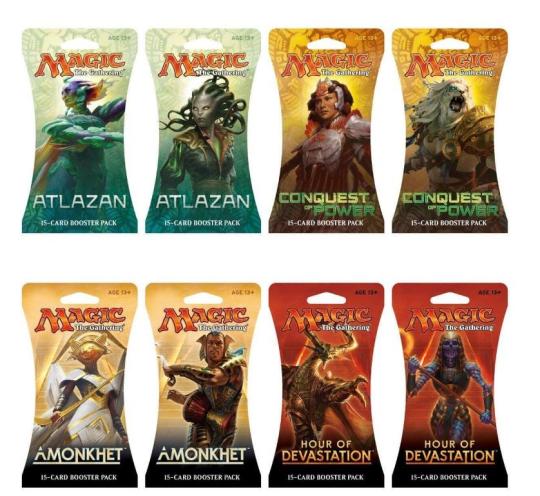
Atlazan and Conquest of Power appear to be names for Ham and Eggs, respectively. But like Warlords of Khanar, they may not be “real” names. Wizards clarified that this survey image was testing packaging concepts, not anything final. But those are hypothetical booster pack designs, with hypothetical set names, with art that was clearly commissioned for something.
While Ham’s plane may not actually be named Atlazan, the plane itself is likely represented by these names and images. So let’s get one thing straight: this is in absolutely no way Atlantis plane. Literally nothing about these names and images says “Atlantis.” Atlantis was a lost city in Greek mythology, already referenced in Theros with Olantis, a coastal polis destroyed by Heliod.
Rather, Atlazan is the Mesoamerican plane. Specifically, it seems to be most influenced by Aztec culture. The Aztec civilization dwelled in what is now central Mexico. The biggest clue to this is the placeholder name itself. “Atlazan” uses sounds common in Nahuatl, the Aztec language. It also bears resemblance to Aztlan, the mythical city the Aztecs are said to have come from.
If you’ve been following the speculation, this probably isn’t news to you. It might also not be news that Vraska is wearing a coat similar to one that would be worn by a Spanish conquistador. You know, the people who invaded Mesoamerica and warred with the native populations. This is a hint of the major conflict that will occur in this block, but there’s an even better one hidden in Magic’s design history.
A Design Conspiracy
If you got a chance to draft Conspiracy: Take the Crown last year, you probably experienced the monarch mechanic. Certain spells would make you the monarch, feeding you cards until an opponent attacked you and seized the crown off your head.

Queen Marchesa by Kieran Yanner
But the monarch mechanic isn’t actually from Fiora. It’s from Atlazan.
Mark Rosewater wrote all about the origins of monarch during the Conspiracy: Take the Crown preview weeks. He told the story of how Shawn Main’s design team was making monarch, a mechanic very similar to one the exploratory design team was toying with for Ham. The mechanic fit Shawn’s set better, so he got to steal it from Ham while Mark’s team went and explored something else instead.
At the time, this was simply a neat behind-the-scenes story. But now we know Ham is this Mesoamerican plane. And at the core of monarch is a mechanic that has two factions fighting for control of a powerful resource.
If you’re keen on Magic design history, this concept should sound familiar. When talking about the Ascendancy cycle from Khans of Tarkir, Mark Rosewater mentioned a number of the iterations that were made before landing on the final versions. Here’s a juicy bit of information:
In one version, the cards represented battlefields that players fought over and the effect went back and forth between players.
Strip away the flavor, and what do you have? You have something almost identical to the monarch mechanic. Even juicier, it was being used in a set to represent factions fighting for control of territory.
Plug all this back into Atlazan. We have a mechanic that was about players fighting for control of something powerful being explored for a set that takes place in Mesoamerica world at the time of the Spanish invasion. The conquistadors were partly driven by stories of golden cities like El Dorado and mystical locations like the Fountain of Youth during their time in the Americas. Magical places that bestowed great fortune upon those that could maintain control of them. Locations that might even spur a Conquest of Power.
While the monarch mechanic was ultimately plucked out of Atlazan’s clutches, another mechanic with the same flavor or emotional texture likely took its place.
Speculation Sunrise
Ultimately, there’s not much else to say about Atlazan right now, if that’s even its real name. We still don’t even know much about Amonkhet and Hour of Devastation, but we could start digging through Kaladesh and Aether Revolt for weird cards that don’t quite fit the set’s themes. These might be hints at what this year of Magic will mechanically contain.
Until next time, planeswalkers, keep your eyes open for the hidden connections between Magic’s past and future.
#Magic The Gathering#MTG#speculation#Atlazan#Conquest of Power#Conspiracy Take the Crown#MTGCN2#monarch#Khans of Tarkir#Warlords of Khanar
139 notes
·
View notes